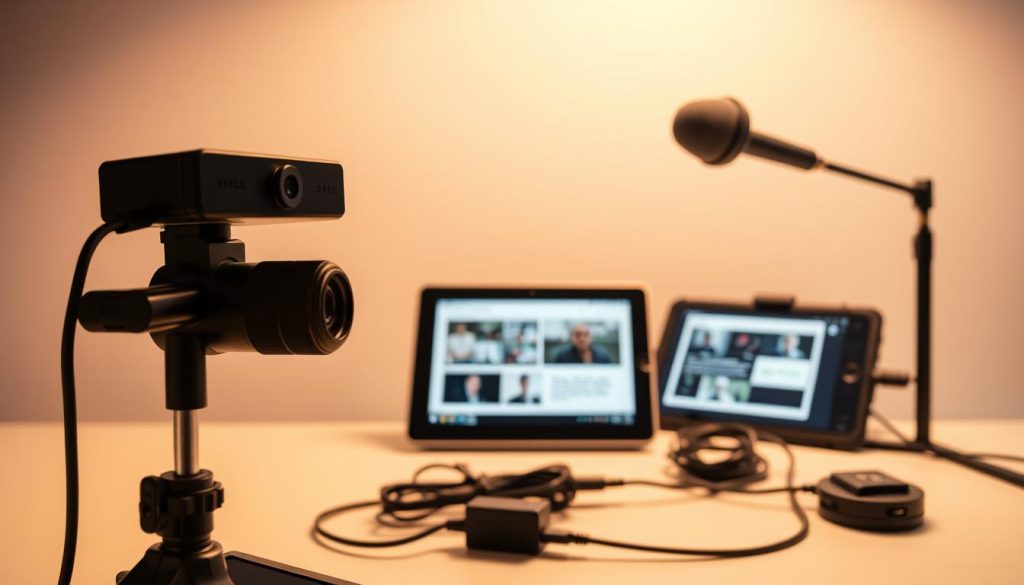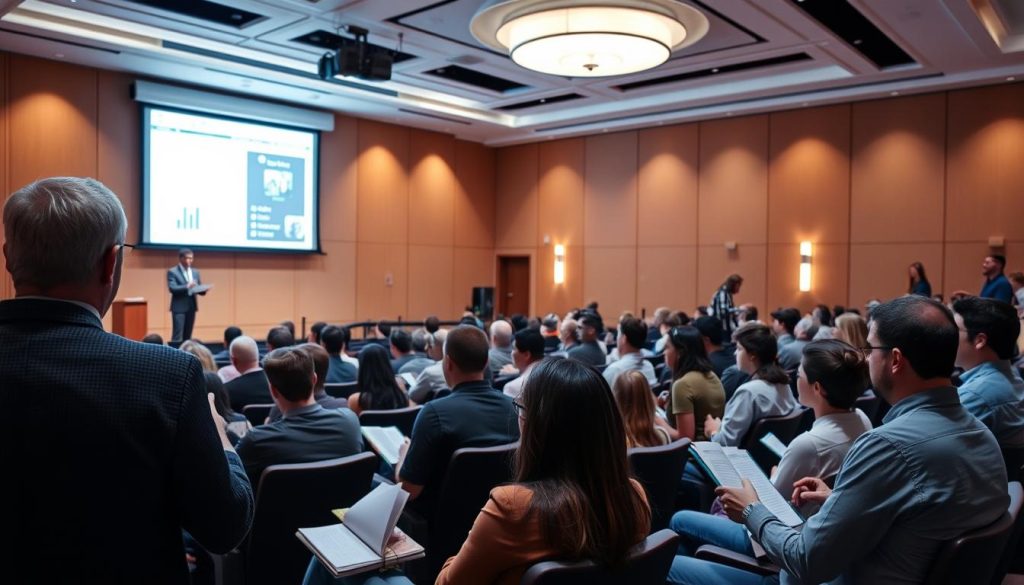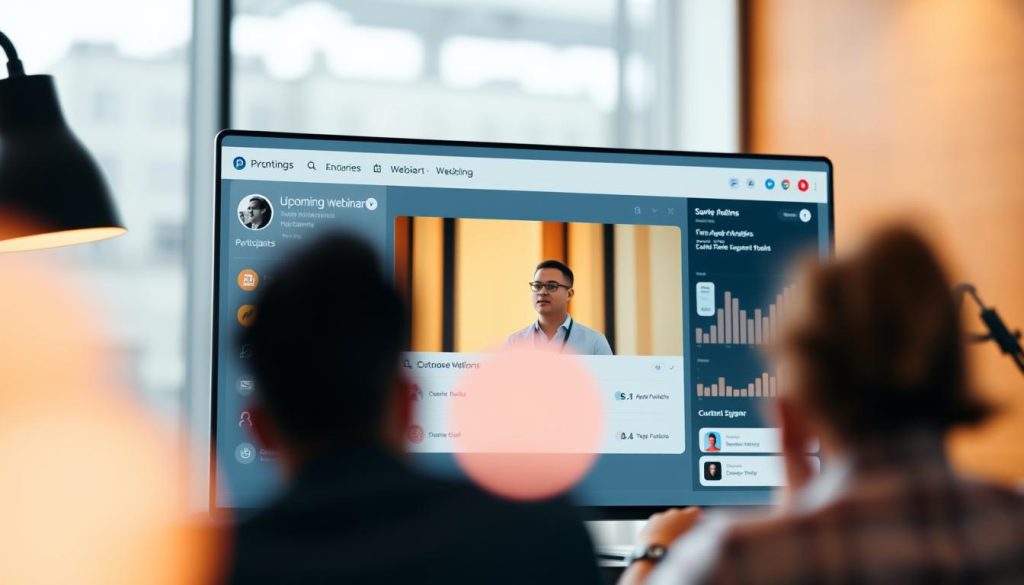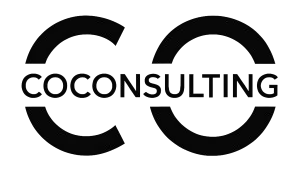We help businesses connect with their audience, showcase their expertise, and drive conversions through effective online marketing strategies.
According to a recent study, 73% of marketing and sales leaders agree that webinars are one of the most effective ways to generate high-quality leads. By leveraging webinar content marketing, businesses can build trust, establish thought leadership, and ultimately drive business growth.
Key Takeaways
- Discover the top strategies used by industry leaders to achieve breakthrough results
- Learn how to effectively leverage webinars to drive conversions
- Understand the importance of building trust and showcasing expertise
- Explore ways to generate high-quality leads through online marketing webinars
- Unlock the full potential of webinar content marketing for your business
Understanding Webinar Content Marketing
In the realm of digital marketing, webinar content marketing stands out as a strategy that demands comprehension. Webinar content marketing involves using online seminars to share a brand’s message, teach the audience something valuable, and generate leads. We leverage webinars to create a platform for real-time interaction, allowing businesses to showcase their expertise and build trust with their audience.
What is Webinar Content Marketing?
Webinar content marketing is a strategic approach that utilizes online seminars to engage with a target audience. It’s about creating and promoting valuable content through webinars to attract and retain a clearly defined audience. By doing so, we aim to drive profitable customer action. Effective webinar content marketing requires a deep understanding of the audience’s needs and preferences.
Benefits of Using Webinars for Marketing
Webinars offer numerous benefits for marketing, including increased brand awareness, lead generation, and the establishment of thought leadership. They provide a unique opportunity for real-time engagement, allowing for immediate feedback and interaction. Some key benefits include:
- Enhanced audience engagement through interactive features
- Cost-effective compared to traditional marketing methods
- Ability to measure engagement and conversion metrics
To illustrate the benefits and components of successful webinars, let’s examine a comparative analysis:
| Webinar Strategy | Engagement Metrics | Conversion Rate |
|---|---|---|
| Interactive Polls | High | 25% |
| Q&A Sessions | Very High | 30% |
| Breakout Rooms | High | 28% |
Key Components of a Successful Webinar
A successful webinar hinges on several key components, including compelling content, effective promotion, and engaging delivery. We must ensure that our webinar content is relevant, informative, and engaging. Additionally, the webinar platform and equipment used should support high-quality audio and visual delivery.

By understanding these elements, we can create a comprehensive webinar strategy that drives results. Our approach to webinar content marketing should be multifaceted, incorporating various techniques to capture and retain audience attention.
Identifying Your Target Audience
A successful webinar starts with a deep understanding of your target audience’s needs and preferences. By knowing who your ideal participants are, you can tailor your content to meet their expectations, thereby increasing engagement and driving conversions.
Defining Your Ideal Participants
To define your ideal participants, consider their demographics, industry, job roles, and the challenges they face. Understanding their pain points allows you to create content that resonates with them. For instance, if your webinar is about “webinar best practices,” your ideal participants might be marketing professionals looking to enhance their webinar strategies.
Conducting Audience Research
Conducting thorough audience research is crucial. This involves gathering data through surveys, social media, and other engagement channels. Analyzing this data helps you understand your audience’s preferences and behaviors. According to a recent study, “understanding your audience is key to creating relevant content that drives engagement.”
“The most successful webinars are those that are tailored to the specific needs and interests of their audience.”
Tailoring Content to Audience Needs
Once you have a clear picture of your target audience, you can tailor your webinar content to meet their needs. This might involve choosing topics that are relevant to their interests, using language that resonates with them, and incorporating marketing webinar tips that are actionable and practical.
- Identify the specific challenges your audience faces.
- Choose topics that address these challenges.
- Use language and examples that resonate with your audience.
By following these steps, you can create a webinar that not only engages your audience but also drives meaningful results for your business.
Crafting Engaging Webinar Content
Engaging webinar content is crucial for capturing and maintaining the audience’s attention in a crowded digital landscape. We understand that creating such content requires a strategic approach, focusing on relevance, structure, and storytelling.
Choosing Relevant Topics
To craft engaging webinar content, we must start by choosing topics that resonate with our audience. This involves understanding their needs, interests, and pain points. Relevant topics are those that address specific challenges or offer valuable insights, making the webinar worthwhile for attendees.
We can identify relevant topics by conducting audience research, analyzing industry trends, and leveraging our expertise. This ensures that our webinar content is not only engaging but also informative and valuable.
Structuring Your Webinar Agenda
A well-structured webinar agenda is essential for maintaining audience engagement. It should logically flow from introduction to conclusion, covering all necessary points. Effective structuring involves allocating sufficient time for each segment, including Q&A sessions.
| Agenda Segment | Time Allocation | Purpose |
|---|---|---|
| Introduction | 5 minutes | Welcome and set expectations |
| Main Content | 40 minutes | Deliver key messages and insights |
| Q&A Session | 15 minutes | Address audience questions and concerns |
| Conclusion | 5 minutes | Summarize key points and call to action |
Utilizing Storytelling Techniques
Storytelling is a powerful tool in webinar content marketing. It helps to make complex information more relatable and engaging. By incorporating storytelling techniques, such as narratives, examples, and anecdotes, we can create a compelling narrative that captures the audience’s attention.

By combining relevant topics, a structured agenda, and storytelling techniques, we can craft engaging webinar content that drives results. This approach not only enhances audience engagement but also contributes to the overall success of our webinar content marketing strategy.
Technology and Tools for Webinars
Webinar success hinges on leveraging the right technology and tools. To deliver a seamless and engaging experience, businesses must invest in the appropriate platforms and equipment.
Essential Webinar Platforms
Choosing the right webinar platform is crucial for a successful online event. Popular options include Zoom, GoToWebinar, and Demio, each offering unique features such as screen sharing, recording capabilities, and audience engagement tools. When selecting a platform, consider factors like the number of attendees, desired interactive features, and ease of use.
“The right webinar platform can make or break your online event,” says a leading expert in digital marketing. “It’s essential to choose a platform that aligns with your goals and audience needs.”
Audio and Visual Equipment Recommendations
High-quality audio and visual equipment are vital for a professional webinar. We recommend investing in a good quality webcam, microphone, and headphones. For optimal video, ensure proper lighting and a stable internet connection. For audio, consider using a dedicated microphone to minimize background noise and ensure clear audio.
- Webcam: Logitech C920 or better
- Microphone: Blue Yeti or similar USB microphones
- Headphones: High-quality headphones to prevent echo
Interactive Features to Enhance Engagement
Interactive features are key to keeping your audience engaged. Utilize polls, Q&A sessions, and live chats to encourage participation. Breakout rooms can also be effective for facilitating discussions and workshops.

By incorporating these technologies and tools, we can significantly enhance the webinar experience, leading to higher engagement and better outcomes. As webinar strategy continues to evolve, staying abreast of the latest online marketing webinar trends and technologies will be crucial for success.
Promoting Your Webinar Effectively
Promoting a webinar effectively requires a multi-faceted approach that leverages various marketing channels. To drive registrations and ultimately achieve the desired marketing goals, businesses must employ a combination of strategies.
Social Media Marketing Strategies
Social media platforms offer a vast opportunity to promote your webinar to a targeted audience. We recommend creating engaging content, such as eye-catching graphics and compelling captions, to capture the attention of potential attendees.
- Utilize Facebook, LinkedIn, Twitter, and other platforms to reach different segments of your audience.
- Share behind-the-scenes content, sneak peeks, and speaker interviews to build anticipation.
- Leverage paid social media advertising to amplify your reach and target specific demographics.
Email Marketing Best Practices
Email marketing remains a powerful tool for promoting webinars. We suggest crafting personalized and compelling email campaigns that highlight the value proposition of your webinar.
- Segment your email list to tailor messages to different audience groups.
- Create a series of emails that build anticipation, provide details, and remind registrants about the upcoming webinar.
- Include clear calls-to-action (CTAs) to encourage registrations and simplify the sign-up process.
Partnering with Influencers for Greater Reach
Partnering with influencers can significantly expand your webinar’s reach. We advise identifying influencers who align with your brand and target audience, and collaborating with them to promote your webinar.
| Influencer Type | Benefits | Action Items |
|---|---|---|
| Niche Influencers | Highly targeted audience, increased credibility | Research and identify niche influencers in your industry. |
| Social Media Influencers | Broad reach, diverse audience engagement | Reach out to influencers with a significant following on relevant platforms. |
| Industry Thought Leaders | Established credibility, authoritative voice | Collaborate with thought leaders to co-host or promote your webinar. |

By integrating these strategies—social media marketing, email marketing, and influencer partnerships—we can effectively promote your webinar and drive registrations. Each channel offers unique benefits and, when used together, they create a comprehensive promotional campaign.
Enhancing Audience Engagement During the Webinar
To create a truly engaging webinar experience, we focus on strategies that captivate and involve our audience. By incorporating interactive elements, we can significantly enhance the overall engagement and make the webinar more memorable.
One effective way to boost engagement is through the use of interactive polls and surveys. These tools allow us to gather feedback, understand our audience’s preferences, and adjust the content accordingly. For instance, we can conduct polls to determine the audience’s interests or use surveys to gauge their understanding of the topic being discussed.
Interactive Polls and Surveys
Interactive polls and surveys are invaluable for making the audience feel involved. They provide instant feedback and can be used to steer the webinar in a direction that is more relevant to the attendees. By using these tools, we can create a more dynamic and engaging experience.
For example, a poll can be used to decide whether to delve deeper into a particular topic or to move on to the next subject. This not only keeps the audience engaged but also ensures that the content remains relevant to their interests.
| Tool | Purpose | Benefits |
|---|---|---|
| Interactive Polls | Gather instant feedback | Increases audience participation |
| Surveys | Understand audience preferences | Helps tailor content to audience needs |
Encouraging Q&A Sessions
Another crucial aspect of enhancing engagement is by encouraging Q&A sessions. This allows the audience to interact with the speakers and clarify any doubts they may have. A well-conducted Q&A session can significantly enhance the overall experience and provide valuable insights to the attendees.
To encourage Q&A sessions, we can invite participants to ask questions throughout the webinar. We can also use breakout rooms to facilitate discussions and encourage attendees to share their thoughts and experiences.
“The art of conversation is the art of hearing as well as being heard.” – William Hazlitt
Utilizing Breakout Rooms for Discussions
Breakout rooms are an effective way to facilitate discussions and encourage collaboration among attendees. By dividing the audience into smaller groups, we can create a more intimate setting where participants feel comfortable sharing their ideas and engaging with one another.
To maximize the effectiveness of breakout rooms, we should ensure that the discussions are well-structured and focused on specific topics. This can be achieved by providing clear instructions and guidelines for the discussions.

Following Up Post-Webinar
The post-webinar phase is where the true value of your efforts is realized. It’s a critical period that can make or break the success of your webinar strategy. By effectively following up, you can maximize the impact of your webinar and drive future results.
Importance of Post-Webinar Communication
Maintaining communication with attendees after the webinar is crucial. It helps in building a lasting relationship with potential clients and keeps them engaged with your brand. Effective post-webinar communication can include sending thank-you emails, providing additional resources, and offering exclusive deals. This not only enhances the attendee’s experience but also increases the chances of converting them into leads.
To illustrate the importance of post-webinar communication, consider the following statistics:
| Communication Strategy | Conversion Rate | Engagement Level |
|---|---|---|
| Thank-you Emails | 25% | High |
| Additional Resources | 30% | Medium |
| Exclusive Offers | 40% | High |
Analyzing Webinar Performance Metrics
Analyzing the performance of your webinar is essential to understanding its effectiveness and identifying areas for improvement. Key metrics to track include attendance rate, engagement levels, and feedback from attendees. By examining these metrics, you can refine your webinar strategy and make data-driven decisions for future webinars.
Some key performance indicators (KPIs) to consider are:
- Attendance rate
- Average viewing time
- Engagement metrics (polls, Q&A, etc.)
- Conversion rates
Leveraging Feedback for Future Webinars
Collecting and leveraging feedback from attendees is vital for improving future webinars. It provides insights into what worked well and what didn’t, allowing you to make necessary adjustments. By incorporating feedback, you can enhance the overall quality of your webinars and increase attendee satisfaction.
To gather feedback effectively, consider using surveys or feedback forms. You can also analyze the data from your webinar platform to identify trends and patterns. By doing so, you can gain valuable marketing webinar tips that will help you refine your strategy.

By following these steps and continually refining your approach, you can maximize the impact of your webinars and achieve your marketing goals.
Creating Evergreen Webinar Content
To maximize the impact of your webinar content, it’s crucial to create evergreen content that remains relevant over time. Evergreen content continues to attract and engage your target audience long after the initial webinar has concluded.
We achieve this by focusing on timeless topics, repackaging content, and utilizing effective marketing strategies. Here, we’ll explore the key steps involved in creating evergreen webinar content.
Repackaging Webinar Content for Longevity
Repackaging your webinar content is essential for extending its lifespan. This involves transforming the content into various formats to cater to different learning preferences.
- Convert webinar recordings into on-demand videos that can be accessed at any time.
- Create blog posts or articles based on the webinar’s key points.
- Design infographics to visually represent data and statistics.
- Develop eBooks or guides that delve deeper into the topics covered.
By repackaging your content, you can reach a wider audience and provide value to those who prefer consuming information in different formats.
Strategies for Converting Live Webinars to On-Demand
Converting live webinars to on-demand content requires careful planning. Here are some strategies to make the transition smooth:
- Record your webinars with high-quality audio and video equipment to ensure a professional finish.
- Edit the recordings to remove any unnecessary parts and make the content more concise.
- Optimize the on-demand content for search engines by using relevant keywords in titles, descriptions, and tags.
- Host the on-demand content on your website or on platforms like YouTube or Vimeo.
By making your webinars available on-demand, you can attract viewers who missed the live event and continue to generate leads.
Marketing Evergreen Webinars
Effective marketing is crucial for the success of your evergreen webinars. Here are some strategies to promote your content:
- Leverage email marketing by sending targeted campaigns to your subscribers.
- Utilize social media platforms to promote your on-demand webinars and engage with your audience.
- Collaborate with influencers in your industry to expand your reach.
- Optimize your webinar landing pages for SEO to attract organic traffic.
By implementing these strategies, you can maximize the visibility and impact of your evergreen webinar content.
Measuring Success in Webinar Content Marketing
To gauge the effectiveness of webinar content marketing, we must track key metrics that indicate success. By doing so, we can refine our webinar strategy and drive future results.
Key Metrics for Success
We track key performance indicators (KPIs) such as registration numbers, attendance rates, and engagement levels to measure the success of our webinars. These metrics provide valuable insights into our webinar’s impact.
Tools for Monitoring Success
Utilizing tools like GoToWebinar and Zoom, we can monitor webinar performance and gather data on attendee engagement. This data helps us identify areas for improvement.
Refining Our Strategy
By analyzing webinar performance metrics, we can adjust our webinar strategy to optimize future webinars. This includes implementing webinar best practices to enhance attendee engagement and drive meaningful results.
By continually refining our approach, we can ensure our webinars remain effective and engaging, ultimately driving business growth.
